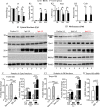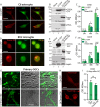Transmembrane protein 100 is expressed in neurons and glia of dorsal root ganglia and is reduced after painful nerve injury
- PMID: 30801043
- PMCID: PMC6370145
- DOI: 10.1097/PR9.0000000000000703
Transmembrane protein 100 is expressed in neurons and glia of dorsal root ganglia and is reduced after painful nerve injury
Abstract
Introduction: Tmem100 modulates interactions between TRPA1 and TRPV1. The cell specificity of Tmem100 expression in dorsal root ganglia (DRGs) is not well defined, nor is the effect of peripheral nerve injury on Tmem100 expression.
Objective: This study was designed to determine the cell specificity of Tmem100 expression in DRG and its subcellular localization, and to examine how Tmem100 expression may be altered in painful conditions.
Methods: Dorsal root ganglion Tmem100 expression was determined by immunohistochemistry, immunoblot, and quantitative real-time PCR, and compared between various experimental rat pain models and controls.
Results: Tmem100 is expressed in both neurons and perineuronal glial cells in the rat DRG. The plasma membrane and intracellular localization of Tmem100 are identified in 83% ± 6% of IB4-positive and 48% ± 6% of calcitonin gene-related peptide-positive neurons, as well as in medium- and large-sized neurons, with its immunopositivity colocalized to TRPV1 (94% ± 5%) and TRPA1 (96% ± 3%). Tmem100 is also detected in the perineuronal satellite glial cells and in some microglia. Tmem100 protein is significantly increased in the lumbar DRGs in the complete Freund adjuvant inflammatory pain. By contrast, peripheral nerve injury by spinal nerve ligation diminishes Tmem100 expression in the injured DRG, with immunoblot and immunohistochemistry experiments showing reduced Tmem100 protein levels in both neurons and satellite glial cells of DRGs proximal to injury, whereas Tmem100 is unchanged in adjacent DRGs. The spared nerve injury model also reduces Tmem100 protein in the injured DRGs.
Conclusion: Our data demonstrate a pain pathology-dependent alteration of DRG Tmem100 protein expression, upregulated during CFA inflammatory pain but downregulated during neuropathic pain.
Keywords: Dorsal root ganglia; Inflammatory pain; Microglia; Neuropathic pain; Primary sensory neurons; Satellite glial cells; Transmembrane protein 100.
Conflict of interest statement
Sponsorships or competing interests that may be relevant to content are disclosed at the end of this article.
Figures









Similar articles
-
Sigma-1 receptor expression in sensory neurons and the effect of painful peripheral nerve injury.Mol Pain. 2013 Sep 10;9:47. doi: 10.1186/1744-8069-9-47. Mol Pain. 2013. PMID: 24015960 Free PMC article.
-
Upregulation of DRG protein TMEM100 facilitates dry-skin-induced pruritus by enhancing TRPA1 channel function.Acta Biochim Biophys Sin (Shanghai). 2022 Dec 25;55(2):404-416. doi: 10.3724/abbs.2022180. Acta Biochim Biophys Sin (Shanghai). 2022. PMID: 36514220 Free PMC article.
-
Involvement of hyperpolarization-activated, cyclic nucleotide-gated cation channels in dorsal root ganglion in neuropathic pain.Sheng Li Xue Bao. 2008 Oct 25;60(5):579-80. Sheng Li Xue Bao. 2008. PMID: 18958363
-
[Contribution of primary sensory neurons and spinal glial cells to pathomechanisms of neuropathic pain].Brain Nerve. 2008 May;60(5):483-92. Brain Nerve. 2008. PMID: 18516970 Review. Japanese.
-
The dorsal root ganglion as a target for neurorestoration in neuropathic pain.Neural Regen Res. 2024 Feb;19(2):296-301. doi: 10.4103/1673-5374.374655. Neural Regen Res. 2024. PMID: 37488881 Free PMC article. Review.
Cited by
-
The Role of IL-6 and TMEM100 in Lumbar Discogenic Pain and the Mechanism of the Glycine-Serine-Threonine Metabolic Axis: A Metabolomic and Molecular Biology Study.J Pain Res. 2023 Feb 15;16:437-461. doi: 10.2147/JPR.S400871. eCollection 2023. J Pain Res. 2023. PMID: 36815126 Free PMC article.
-
TMEM100 Regulates Neuropathic Pain by Reducing the Expression of Inflammatory Factors.Mediators Inflamm. 2023 Jul 10;2023:9151967. doi: 10.1155/2023/9151967. eCollection 2023. Mediators Inflamm. 2023. PMID: 37469758 Free PMC article.
-
Piezo2 mechanosensitive ion channel is located to sensory neurons and nonneuronal cells in rat peripheral sensory pathway: implications in pain.Pain. 2021 Nov 1;162(11):2750-2768. doi: 10.1097/j.pain.0000000000002356. Pain. 2021. PMID: 34285153 Free PMC article.
-
Hemokinin-1 Gene Expression Is Upregulated in Trigeminal Ganglia in an Inflammatory Orofacial Pain Model: Potential Role in Peripheral Sensitization.Int J Mol Sci. 2020 Apr 22;21(8):2938. doi: 10.3390/ijms21082938. Int J Mol Sci. 2020. PMID: 32331300 Free PMC article.
-
The Role of a Lung Vascular Endothelium Enriched Gene TMEM100.Biomedicines. 2023 Mar 17;11(3):937. doi: 10.3390/biomedicines11030937. Biomedicines. 2023. PMID: 36979916 Free PMC article. Review.
References
-
- Aoki Y, Ohtori S, Takahashi K, Ino H, Takahashi Y, Chiba T, Moriya H. Innervation of the lumbar intervertebral disc by nerve growth factor-dependent neurons related to inflammatory pain. Spine (Phila Pa 1976) 2004;29:1077–81. - PubMed
-
- Bailey AL, Ribeiro-da-Silva A. Transient loss of terminals from non-peptidergic nociceptive fibers in the substantia gelatinosa of spinal cord following chronic constriction injury of the sciatic nerve. Neuroscience 2006;138:675–90. - PubMed
Grants and funding
LinkOut - more resources
Full Text Sources
